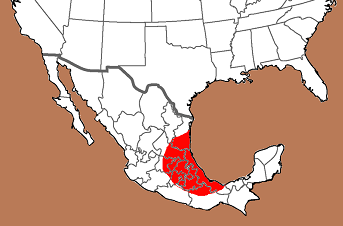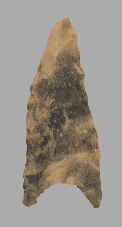Outline is Representative of Size and Shape:


Name Details:
Identified By: Richard "Scotty" MacNeish
Named For:
Date Identified: 1961
Type Site:
Identified By: Richard "Scotty" MacNeish
Named For:
Date Identified: 1961
Type Site:
Point Validity:
Valid type
MacNeish was a pioneering anthropologist who was most notable for his excavations and studies at Tamaulipas Mexico. This type has been references in professional publications and is considered a valid type.
MacNeish was a pioneering anthropologist who was most notable for his excavations and studies at Tamaulipas Mexico. This type has been references in professional publications and is considered a valid type.
Flacco Lanceolate
Cluster: Description of Physical Characteristics and Flaking Pattern:
This is a medium lanceolate with an elliptical cross section. The blade is excurvate with the tip curving in. The blade may become parallel towards the base giving a lanceolate appearance, but in examples that do not have the blade becoming parallel, the overall outline is triangular or pentagonal. The base is deeply concaved with almost spur like or barb like basal ears. The base may range from having a V appearance to a deep U shape. Heavy grinding is commonly seen on the hafting area including basal grinding and basal thinning flakes. This type is formed by percussion flaking to form the preform, then finely controlled percussion flaking or pressure flaking being used to finish the point. The flaking pattern is generally random, but collateral is sometimes seen.
Size Measurements:
Length - 32 to 57 mm (average 42 mm), Width - 18 to 33 mm (average 28 mm), Thickness - 6 to 13 mm (average 9 mm), Basal Concavity - 3 to 9 mm (average 6 mm) (MacNeish, 1967)
Length - 32 to 57 mm (average 42 mm), Width - 18 to 33 mm (average 28 mm), Thickness - 6 to 13 mm (average 9 mm), Basal Concavity - 3 to 9 mm (average 6 mm) (MacNeish, 1967)
Commonly Utilized Material:
Additional Comments:
Flacco points are a later point and seem to have evolved from the earlier El Riego points (MacNeish, 1967).
Flacco points are a later point and seem to have evolved from the earlier El Riego points (MacNeish, 1967).
Distribution:

Distribution Comments:
This point is primarily found in the Tehuacan Valley of Mexico. They have been reported at Tecolota Cave in Hidalgo, San Nicoles Cave in Querertaro and surface finds in Southern Tamaulipas and the Valley of Mexico.
This point is primarily found in the Tehuacan Valley of Mexico. They have been reported at Tecolota Cave in Hidalgo, San Nicoles Cave in Querertaro and surface finds in Southern Tamaulipas and the Valley of Mexico.
Age / Periods:
Date: 6,800 - 4,000 B.P.
Cultural Period: Early to Middle Archaic
Glacial Period: Middle Holocene
Culture:
Date: 6,800 - 4,000 B.P.
Cultural Period: Early to Middle Archaic
Glacial Period: Middle Holocene
Culture:
Age Details:




